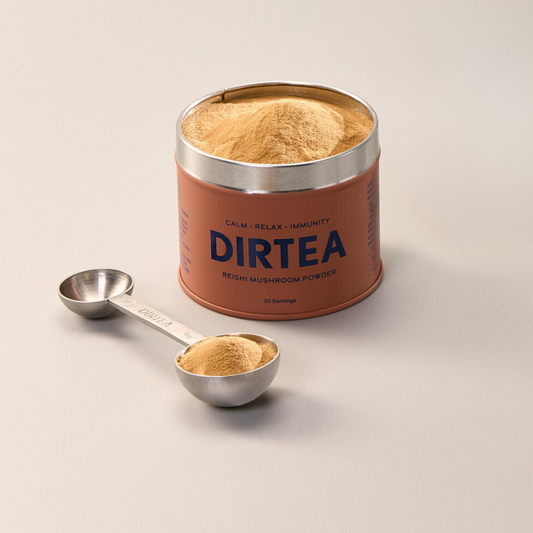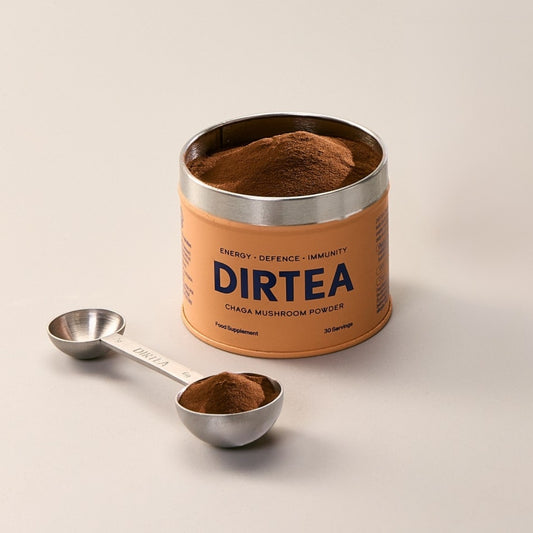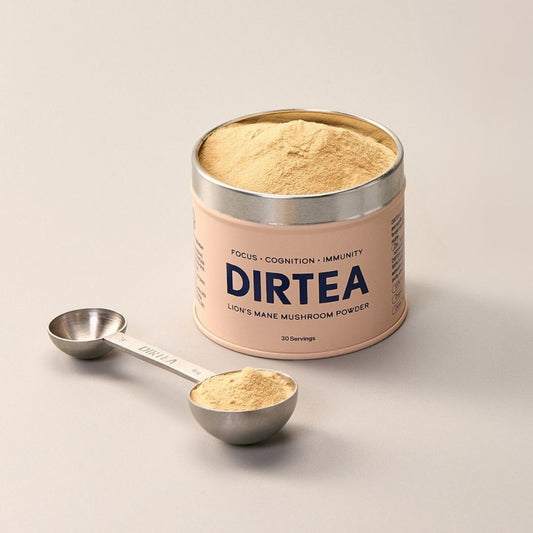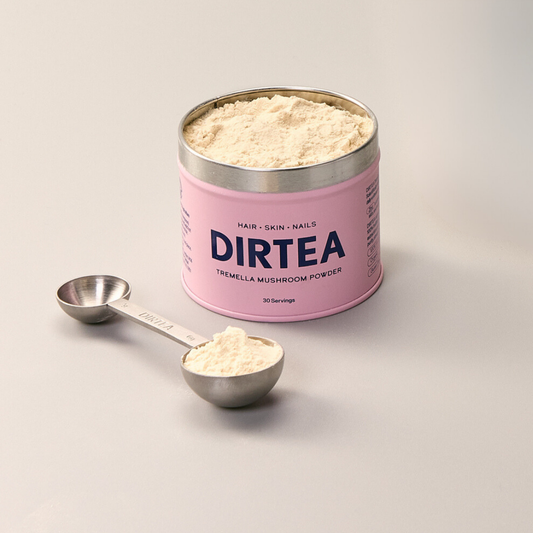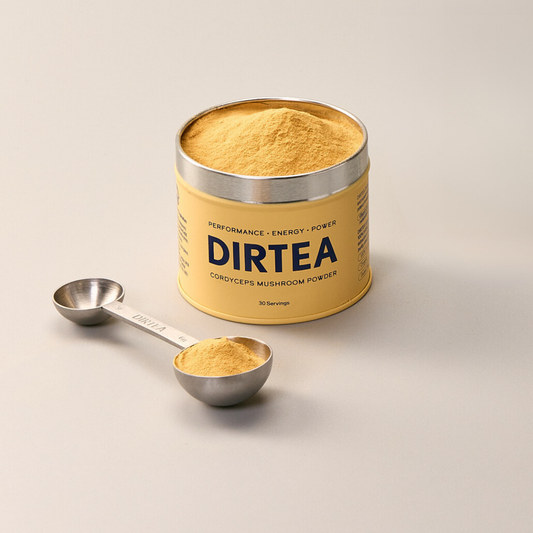Terpenes vs Triterpenes: The Compounds Behind Mushrooms’ Power

Share
Terpenes vs Triterpenes: The Compounds Behind Mushrooms’ Power
Terpenes are a big family of natural aroma compounds—built from tiny five-carbon “blocks”—that give mushrooms their woody, spicy notes (think that forest smell). Fungi make them in different sizes:
- Small: Monoterpenes
- Medium: Sesquiterpenes
- Larger: Diterpenes
When oxygen is added, they’re called terpenoids (same family, just tweaked).
Triterpenes are the bigger, sturdier cousins—common in Reishi and Chaga—and they bring a more bitter, resinous, herbal character. All of these are made by fungal “assembly-line” enzymes called terpene synthases, which ultimately shape the flavour and aroma of your brew or extract.
So… what makes triterpenes different?
“Triterpenes” are simply terpenes with six isoprene units (C30). They’re bulkier, less volatile, and often form complex ring shapes.
In mushrooms, triterpenes (and their oxygenated cousins, triterpenoids) are particularly abundant in Reishi and Chaga. If you’ve tasted classic Reishi tea and thought “bitter,” that’s the triterpene family speaking—especially lanostane-type compounds such as ganoderic acids in Reishi and inotodiol in Chaga.
Mushroom Examples
Reishi: Lanostane triterpenes
Reishi is famous for its lanostane-type triterpenoids. These give Reishi its recognisable bitter, resinous edge, which formulators balance with creaminess (such as coconut/oat), cacao, or warming spices. A recent review catalogued hundreds of distinct Reishi triterpenoids identified over the last few decades—showing how chemically rich this genus is.
Lion’s Mane: Cyathane diterpenes
Lion’s Mane chemistry is often discussed around two families: erinacines (primarily from the mycelium; these are diterpenoids) and hericenones (more associated with the fruiting body; often classed as aromatic/meroterpenoid-like compounds).
Translation: Lion’s Mane tends to be gentler on taste—more bready/nutty—because its signature molecules are smaller terpenoids (diterpenes) rather than the very bitter triterpenes you meet in Reishi.
Chaga: Inotodiol, betulinic acid
Chaga grows on birch and is associated with inotodiol (a lanostane triterpenoid), plus betulinic acid (a triterpenoid related to birch chemistry). Together they contribute to Chaga’s toasty, woody profile.
Taste note for formulators and fans:
- Triterpenes → often bitter/tonic (Reishi, Chaga)
- Diterpenes/volatiles → often aromatic/neutral (Lion’s Mane tends milder)
Why this matters in your cup (and on your label)
|
Consideration |
What it means for taste & aroma |
Practical tip for your ritual |
|
Aroma & flavour |
Smaller terpenes (mono-/sesquiterpenes) are more volatile and aromatic—you’ll smell them. Triterpenes show up more on the palate as a lingering bitter/tonic note. |
If you want a fragrant cup, keep preparations lighter; if you enjoy a tonic bite (e.g., Reishi), lean into richer recipes. |
|
Brewing & blending |
Longer, hotter extractions pull more triterpenes (more bitterness). Shorter, cooler methods keep things lighter and more aromatic. |
Try Reishi in cacao, add honey or creamy milks for balance; use shorter steeps for a brighter, lighter profile. |
|
Powders vs gummies |
Powders carry the truest mushroom taste. Gummies can mask bitterness and keep serving sizes simple. |
Love the ritual but not the bite? Choose gummies. Want the full flavour? Go powders. |
|
Reading labels |
Species, plant part, and extraction shape the “triterpene bass” vs “terpene top-notes.” |
Look for species (e.g., Ganoderma lucidum), part (fruiting body vs mycelium), and extraction to predict taste and intensity. |
Quick cheat-sheet
|
Term |
What it means (simple) |
Where you meet it in mushrooms |
What you’ll notice |
|
Terpene |
Big family of natural compounds built from isoprene units |
Many species; includes mono-, sesqui-, di-terpenes |
Often the aroma/flavour you can smell |
|
Terpenoid |
Oxygen-tweaked terpene |
Common across fungi |
Similar to terpenes, sometimes less volatile |
|
Diterpene |
Medium-sized terpene (C20) |
Lion’s Mane erinacines (mycelium) |
Usually milder taste than triterpenes |
|
Triterpene |
Large terpene (C30) |
Reishi ganoderic acids; Chaga inotodiol |
Bitter/tonic backbone in taste |
|
Lanostane-type |
A classic triterpene skeleton |
Reishi, Chaga |
Signature “herbal-bitter” note |
Terpenes vs triterpenes: five takeaways
- Same family tree, different sizes: triterpenes are the bigger cousins of terpenes.
- Aroma vs backbone: small terpenes often shape the smell; triterpenes lend the bitter backbone.
- Species and part matter: Reishi fruiting bodies are classic for triterpenoids; Lion’s Mane mycelium is a key source of erinacines (diterpenoids).
- Extraction steers flavour: time, temperature and solvent change the terpene/triterpene balance in your cup.
- Labels tell a story: species, plant part, and extraction type help you predict taste and mouthfeel.
Final thoughts
Understanding terpenes vs triterpenes helps you read labels, predict taste, and build rituals you actually enjoy. Whether you’re a Reishi-at-night traditionalist, a Lion’s Mane-with-matcha minimalist, or a Chaga-by-the-fire fan, you’re tasting the chemistry—and writing your own modern mushroom story with every cup.
FAQs
Q1: Are terpenes and terpenoids the same thing?
They’re close. Terpenes are hydrocarbons; terpenoids are the same family with oxygen added. Think of terpenes as the starting blocks, and terpenoids as those same blocks after a light makeover—usually adding oxygen or small tweaks..
Q2: Where do terpenes live in mushrooms—fruiting body or mycelium?
Both can contain them. With Lion’s Mane, you’ll commonly see erinacines linked to mycelium and hericenones linked to the fruiting body; Reishi triterpenoids are frequently highlighted in fruiting bodies. Always check the label and literature for the specific product you’re using.
Q3: Why is Reishi bitter while Lion’s Mane tastes mild?
Reishi is rich in lanostane-type triterpenoids (ganoderic acids), which often taste bitter/tonic. Lion’s Mane’s hallmark compounds—erinacines (diterpenoids) and hericenones—tend to produce a gentler flavour profile.
Q4: Do all triterpenes taste the same?
No—there’s a huge variety. Even within Reishi, researchers have catalogued hundreds of different triterpenoids with slightly different structures. The overall impression to drinkers is often “tonic” or “resinous.”
Q5: What gives Chaga its toasty, woody character?
Compounds like inotodiol and related triterpenoids contribute to Chaga’s roasty flavour; its relationship with birch also connects it to betulinic derivatives. Recent analyses quantify inotodiol among the more abundant triterpenoids in certain Chaga preparations.
Q6: Do gummies or powders “keep” these compounds?
They can—formulation and processing are key. Powders tend to carry the native taste profile; gummies can mask bitterness while standardising servings.
Q7: How do I choose between them?
Let taste + ritual decide.
- Love rich, cacao-like drinks? Try Reishi or Chaga (balanced with milk/cacao).
- Prefer coffee/matcha clarity? Lion’s Mane fits neatly.
- Want an easy pre-session routine? Cordyceps is a calm, earthy scoop.
References (selected)
- González-Hernández, R. A., et al. (2023). Overview of fungal terpene synthases and their regulation. Frontiers in Microbiology. PMC


